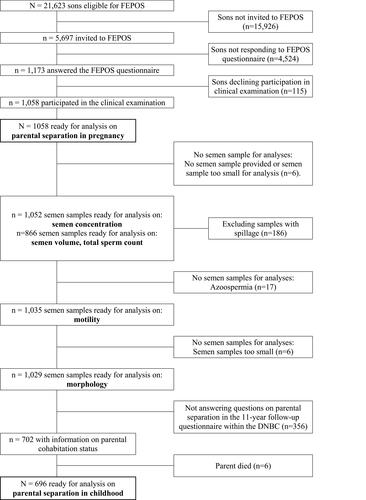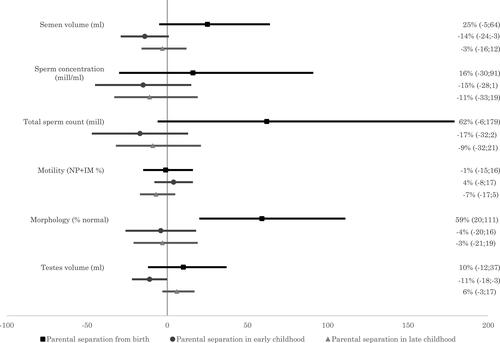Figures & data
Figure 1 Flowchart on the inclusion of participants in the fetal programming of semen quality (FEPOS) cohort, nested within the Danish National Birth Cohort, Denmark, 1998–2019.

Table 1 Baseline Characteristics. Maternal and Semen Quality Characteristics According to Parental Separation in Pregnancy Among 1058 Young Men from FEPOS, Denmark, 1998–2019
Table 2 Baseline Characteristics. Maternal and Semen Quality Characteristics According to Parental Separation in Childhood Among 696 Young Men from FEPOS, Denmark, 1998–2019
Table 3 Descriptive Statisticsa. Semen Quality Characteristics and Testes Volume According to (A) Parental Separation in Pregnancy; (B) Parental Separation in Childhood; and (C) Parental Separation According to Timing of Parental Separation in Childhood in Young Men from FEPOS, Denmark, 2017–2019
Figure 2 Main results for parental separation in pregnancy or in childhood. Relative percentage differences in semen quality and testes volume according to parental separation in pregnancy (square and dark grey (N=1,058)) or in childhood (circle and black (N=696)). Parental separation relatively to no parental separation (vertical line). Adjusted for maternal age at delivery; maternal social class; maternal first trimester smoking; abstinence time; place of semen sample collection (not testes volume); spillage (not testes volume). Motility further adjusted for interval between ejaculation and analysis in minutes. Due to model fit, the figure show results for NP (non-progressive) + IM (immotile) spermatozoa. Therefore, negative estimates represent a higher proportion of progressive motility, and positive estimates represent a lower proportion of progressive motility. Point estimates with 95% confidence intervals are shown to the right.

Figure 3 Main results exploring the timing of parental separation in childhood. Relative percentage differences in semen quality and testes volume according to timing of parental separation in childhood (N=696). Parental separation from birth (square and black), in early childhood (circle and dark grey) or in late childhood (triangle and light grey) relatively to no parental separation (vertical line). Adjusted for maternal age at delivery; maternal social class; maternal first trimester smoking; abstinence time; place of semen sample collection (not testes volume); spillage (not testes volume). Motility further adjusted for interval between ejaculation and analysis in minutes. Due to model fit, the figure show results for NP (non-progressive) + IM (immotile) spermatozoa. Therefore, negative estimates represent a higher proportion of progressive motility, and positive estimates represent a lower proportion of progressive motility. Point estimates with 95% confidence intervals are shown to the right.

